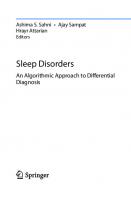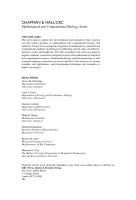Automata Theory : An Algorithmic Approach 9780262376938, 9780262048637, 9780262376945
A comprehensive introduction to automata theory that uses the novel approach of viewing automata as data structures. Thi
132 76 33MB
English Pages 560 Year 2023
Table of contents :
Cover Page
Title Page
Copyright Page
Dedication
Table of Contents
Preface
Why This Book?
Acknowledgments
0. Overview
0.1. Introduction
0.2. Outline and Structure
0.3. On the Exercises
I. Automata on Finite Words
1. Automata Classes and Conversions
1.1. Alphabets, Letters, Words, and Languages
1.2. Regular Expressions: A Language to Describe Languages
1.3. Automata Classes
1.3.1. Deterministic Finite Automata
1.3.2. Using DFAs as Data Structures
1.3.3. Nondeterministic Finite Automata
1.3.4. Nondeterministic Finite Automata with ε-Transitions
1.3.5. Nondeterministic Finite Automata with Regular Expressions
1.3.6. A Normal Form for Automata
1.4. Conversion Algorithms
1.4.1. From NFA to DFA
1.4.2. From NFA-ε to NFA
1.4.3. From NFA-reg to NFA-ε
1.4.4. From NFA-ε to Regular Expressions
1.5. A Tour of Conversions
1.6. Exercises
2. Minimization and Reduction
2.1. Minimal DFAs
2.1.1. The Master Automaton
2.2. Minimizing DFAs
2.2.1. Computing the Language Partition
2.2.2. Quotienting
2.2.3. Hopcroft’s Algorithm
2.3. Reducing NFAs
2.3.1. The Reduction Algorithm
2.3.2. * Minimality Is PSPACE-Complete
2.4. A Characterization of Regular Languages
2.5. Exercises
3. Operations on Sets: Implementations
3.1. Implementation on DFAs
3.1.1. Membership
3.1.2. Complementation
3.1.3. Binary Boolean Operations
3.1.4. Emptiness
3.1.5. Universality
3.1.6. Inclusion
3.1.7. Equality
3.2. Implementation on NFAs
3.2.1. Membership
3.2.2. Complementation
3.2.3. Union and Intersection
3.2.4. Emptiness and Universality
3.2.5. Inclusion and Equality
3.2.6. * Universality and Inclusion Are PSPACE-Complete
3.3. Exercises
4. Application I: Pattern Matching
4.1. The General Case
4.2. The Word Case
4.2.1. Lazy DFAs
4.3. Exercises
5. Operations on Relations: Implementations
5.1. Encodings
5.2. Transducers and Regular Relations
5.3. Implementing Operations on Relations
5.3.1. Projection
5.3.2. Join, Post and Pre
5.4. Relations of Higher Arity
5.5. Exercises
6. Finite Universes and Decision Diagrams
6.1. Fixed-Length Languages and the Master Automaton
6.2. A Data Structure for Fixed-Length Languages
6.3. Operations on Fixed-Length Languages
6.4. Determinization and Minimization
6.4.1. An Application: Equivalence of Digital Circuits
6.5. Operations on Fixed-Length Relations
6.6. Decision Diagrams
6.6.1. Decision Diagrams and Kernels
6.6.2. Operations on Kernels
6.6.3. Determinization and Minimization
6.7. Exercises
7. Application II: Verification
7.1. The Automata-Theoretic Approach to Verification
7.2. Programs as Networks of Automata
7.2.1. Parallel Composition of Languages
7.2.2. Asynchronous Product
7.2.3. State- and Action-Based Properties
7.3. Concurrent Programs
7.3.1. Expressing and Checking Properties
7.4. Coping with the State-Explosion Problem
7.4.1. * Verification Is PSPACE-Complete
7.4.2. On-the-Fly Verification
7.4.3. Compositional Verification
7.4.4. Symbolic State-Space Exploration
7.5. Safety and Liveness Properties
7.6. Exercises
8. Automata and Logic
8.1. Predicate Logic on Words: An Informal Introduction
8.2. Syntax and Semantics
8.2.1. Syntax
8.2.2. Semantics
8.3. Macros and Examples
8.4. Expressive Power of FO(Σ)
8.5. Monadic Second-Order Logic on Words
8.6. Syntax and Semantics
8.6.1. Syntax
8.6.2. Semantics
8.7. Macros and Examples
8.8. All Regular Languages Are Expressible in MSO(Σ)
8.9. All Languages Expressible in MSO(Σ) Are Regular
8.10. Exercises
9. Application III: Presburger Arithmetic
9.1. Syntax and Semantics
9.2. An NFA for the Solutions over the Naturals
9.2.1. Equations
9.3. An NFA for the Solutions over the Integers
9.3.1. Equations
9.3.2. Algorithms
9.4. Exercises
II. Automata on Infinite Words
10. Classes of ω-Automata and Conversions
10.1. ω-Languages and ω-Regular Expressions
10.2. ω-Automata and the Quest for an ω-Trinity
10.2.1. The Quest for an ω-Trinity
10.2.2. Büchi Automata
10.2.3. Co-Büchi automata
10.2.4. Rabin Automata
10.3. Beyond ω-Trinities
10.3.1. Rabin Automata, Again
10.3.2. Streett Automata
10.3.3. Parity Automata
10.3.4. Muller Automata
10.4. Summary
10.5. Exercises
11. Boolean Operations: Implementations
11.1. Generalized Büchi Automata
11.2. Union and Intersection
11.3. Complement
11.3.1. Rankings and Level Rankings
11.3.2. The Complement NBA A
11.3.3. A Lower Bound on the Size of A
11.4. Exercises
12. Emptiness Check: Implementations
12.1. Emptiness Algorithms Based on Depth-First Search
12.1.1. The Nested-DFS Algorithm
12.1.2. An Algorithm Based on Strongly Connected Components
12.2. Algorithms Based on Breadth-First Search
12.2.1. Emerson–Lei’s Algorithm
12.2.2. A Modified Emerson–Lei’s Algorithm
12.2.3. Comparing the Algorithms
12.3. Exercises
13. Application I: Verification and Temporal Logic
13.1. Automata-Based Verification of Liveness Properties
13.1.1. Checking Liveness Properties
13.1.2. Networks of Automata and Fairness
13.2. Linear Temporal Logic
13.3. From LTL Formulas to Generalized Büchi Automata
13.3.1. Satisfaction Sequences and Hintikka Sequences
13.3.2. Constructing the NGA for an LTL Formula
13.3.3. Size of the NGA
13.4. Automatic Verification of LTL Formulas
13.5. Exercises
14. Application II: Logics on ω-Words and Linear Arithmetic
14.1. Monadic Second-Order Logic on ω-Words
14.1.1. Expressive Power of MSO(Σ) on ω-Words
14.2. Linear Arithmetic
14.2.1. Encoding Real Numbers
14.2.2. Constructing an NGA for the Real Solutions
14.3. Exercises
Solutions
Solutions for Chapter 1
Solutions for Chapter 2
Solutions for Chapter 3
Solutions for Chapter 4
Solutions for Chapter 5
Solutions for Chapter 6
Solutions for Chapter 7
Solutions for Chapter 8
Solutions for Chapter 9
Solutions for Chapter 10
Solutions for Chapter 11
Solutions for Chapter 12
Solutions for Chapter 13
Solutions for Chapter 14
Bibliography Notes
Bibliography
Index
Cover Page
Title Page
Copyright Page
Dedication
Table of Contents
Preface
Why This Book?
Acknowledgments
0. Overview
0.1. Introduction
0.2. Outline and Structure
0.3. On the Exercises
I. Automata on Finite Words
1. Automata Classes and Conversions
1.1. Alphabets, Letters, Words, and Languages
1.2. Regular Expressions: A Language to Describe Languages
1.3. Automata Classes
1.3.1. Deterministic Finite Automata
1.3.2. Using DFAs as Data Structures
1.3.3. Nondeterministic Finite Automata
1.3.4. Nondeterministic Finite Automata with ε-Transitions
1.3.5. Nondeterministic Finite Automata with Regular Expressions
1.3.6. A Normal Form for Automata
1.4. Conversion Algorithms
1.4.1. From NFA to DFA
1.4.2. From NFA-ε to NFA
1.4.3. From NFA-reg to NFA-ε
1.4.4. From NFA-ε to Regular Expressions
1.5. A Tour of Conversions
1.6. Exercises
2. Minimization and Reduction
2.1. Minimal DFAs
2.1.1. The Master Automaton
2.2. Minimizing DFAs
2.2.1. Computing the Language Partition
2.2.2. Quotienting
2.2.3. Hopcroft’s Algorithm
2.3. Reducing NFAs
2.3.1. The Reduction Algorithm
2.3.2. * Minimality Is PSPACE-Complete
2.4. A Characterization of Regular Languages
2.5. Exercises
3. Operations on Sets: Implementations
3.1. Implementation on DFAs
3.1.1. Membership
3.1.2. Complementation
3.1.3. Binary Boolean Operations
3.1.4. Emptiness
3.1.5. Universality
3.1.6. Inclusion
3.1.7. Equality
3.2. Implementation on NFAs
3.2.1. Membership
3.2.2. Complementation
3.2.3. Union and Intersection
3.2.4. Emptiness and Universality
3.2.5. Inclusion and Equality
3.2.6. * Universality and Inclusion Are PSPACE-Complete
3.3. Exercises
4. Application I: Pattern Matching
4.1. The General Case
4.2. The Word Case
4.2.1. Lazy DFAs
4.3. Exercises
5. Operations on Relations: Implementations
5.1. Encodings
5.2. Transducers and Regular Relations
5.3. Implementing Operations on Relations
5.3.1. Projection
5.3.2. Join, Post and Pre
5.4. Relations of Higher Arity
5.5. Exercises
6. Finite Universes and Decision Diagrams
6.1. Fixed-Length Languages and the Master Automaton
6.2. A Data Structure for Fixed-Length Languages
6.3. Operations on Fixed-Length Languages
6.4. Determinization and Minimization
6.4.1. An Application: Equivalence of Digital Circuits
6.5. Operations on Fixed-Length Relations
6.6. Decision Diagrams
6.6.1. Decision Diagrams and Kernels
6.6.2. Operations on Kernels
6.6.3. Determinization and Minimization
6.7. Exercises
7. Application II: Verification
7.1. The Automata-Theoretic Approach to Verification
7.2. Programs as Networks of Automata
7.2.1. Parallel Composition of Languages
7.2.2. Asynchronous Product
7.2.3. State- and Action-Based Properties
7.3. Concurrent Programs
7.3.1. Expressing and Checking Properties
7.4. Coping with the State-Explosion Problem
7.4.1. * Verification Is PSPACE-Complete
7.4.2. On-the-Fly Verification
7.4.3. Compositional Verification
7.4.4. Symbolic State-Space Exploration
7.5. Safety and Liveness Properties
7.6. Exercises
8. Automata and Logic
8.1. Predicate Logic on Words: An Informal Introduction
8.2. Syntax and Semantics
8.2.1. Syntax
8.2.2. Semantics
8.3. Macros and Examples
8.4. Expressive Power of FO(Σ)
8.5. Monadic Second-Order Logic on Words
8.6. Syntax and Semantics
8.6.1. Syntax
8.6.2. Semantics
8.7. Macros and Examples
8.8. All Regular Languages Are Expressible in MSO(Σ)
8.9. All Languages Expressible in MSO(Σ) Are Regular
8.10. Exercises
9. Application III: Presburger Arithmetic
9.1. Syntax and Semantics
9.2. An NFA for the Solutions over the Naturals
9.2.1. Equations
9.3. An NFA for the Solutions over the Integers
9.3.1. Equations
9.3.2. Algorithms
9.4. Exercises
II. Automata on Infinite Words
10. Classes of ω-Automata and Conversions
10.1. ω-Languages and ω-Regular Expressions
10.2. ω-Automata and the Quest for an ω-Trinity
10.2.1. The Quest for an ω-Trinity
10.2.2. Büchi Automata
10.2.3. Co-Büchi automata
10.2.4. Rabin Automata
10.3. Beyond ω-Trinities
10.3.1. Rabin Automata, Again
10.3.2. Streett Automata
10.3.3. Parity Automata
10.3.4. Muller Automata
10.4. Summary
10.5. Exercises
11. Boolean Operations: Implementations
11.1. Generalized Büchi Automata
11.2. Union and Intersection
11.3. Complement
11.3.1. Rankings and Level Rankings
11.3.2. The Complement NBA A
11.3.3. A Lower Bound on the Size of A
11.4. Exercises
12. Emptiness Check: Implementations
12.1. Emptiness Algorithms Based on Depth-First Search
12.1.1. The Nested-DFS Algorithm
12.1.2. An Algorithm Based on Strongly Connected Components
12.2. Algorithms Based on Breadth-First Search
12.2.1. Emerson–Lei’s Algorithm
12.2.2. A Modified Emerson–Lei’s Algorithm
12.2.3. Comparing the Algorithms
12.3. Exercises
13. Application I: Verification and Temporal Logic
13.1. Automata-Based Verification of Liveness Properties
13.1.1. Checking Liveness Properties
13.1.2. Networks of Automata and Fairness
13.2. Linear Temporal Logic
13.3. From LTL Formulas to Generalized Büchi Automata
13.3.1. Satisfaction Sequences and Hintikka Sequences
13.3.2. Constructing the NGA for an LTL Formula
13.3.3. Size of the NGA
13.4. Automatic Verification of LTL Formulas
13.5. Exercises
14. Application II: Logics on ω-Words and Linear Arithmetic
14.1. Monadic Second-Order Logic on ω-Words
14.1.1. Expressive Power of MSO(Σ) on ω-Words
14.2. Linear Arithmetic
14.2.1. Encoding Real Numbers
14.2.2. Constructing an NGA for the Real Solutions
14.3. Exercises
Solutions
Solutions for Chapter 1
Solutions for Chapter 2
Solutions for Chapter 3
Solutions for Chapter 4
Solutions for Chapter 5
Solutions for Chapter 6
Solutions for Chapter 7
Solutions for Chapter 8
Solutions for Chapter 9
Solutions for Chapter 10
Solutions for Chapter 11
Solutions for Chapter 12
Solutions for Chapter 13
Solutions for Chapter 14
Bibliography Notes
Bibliography
Index

- Author / Uploaded
- Javier Esparza
- Michael Blondin
- Similar Topics
- Computers
- Algorithms and Data Structures

![Solution to Peter Linz, an introduction to Automata theory [2.43]](https://ebin.pub/img/200x200/solution-to-peter-linz-an-introduction-to-automata-theory-243.jpg)






![Protein Bioinformatics: An Algorithmic Approach to Sequence and Structure Analysis [1 ed.]
0470848391, 9780470848395](https://ebin.pub/img/200x200/protein-bioinformatics-an-algorithmic-approach-to-sequence-and-structure-analysis-1nbsped-0470848391-9780470848395.jpg)
